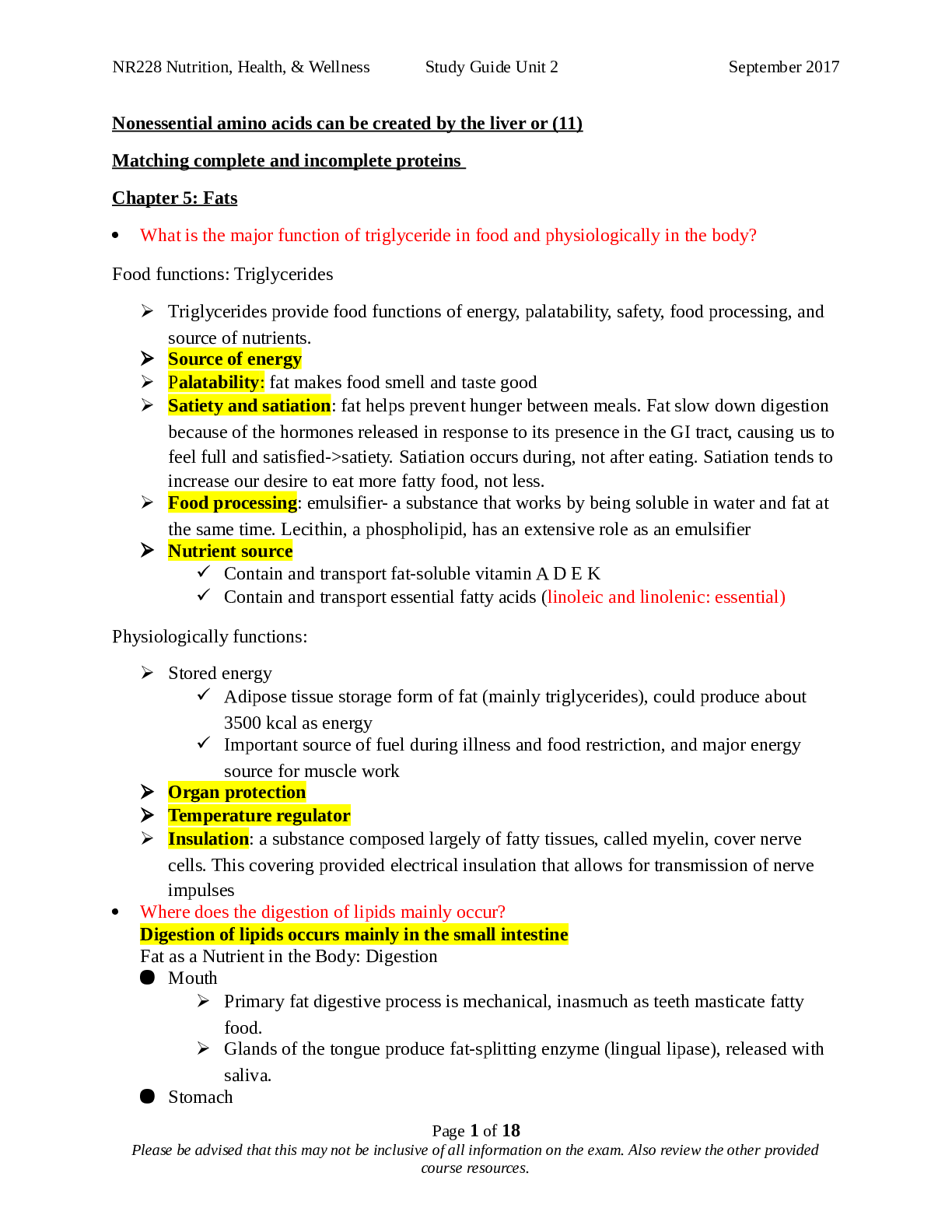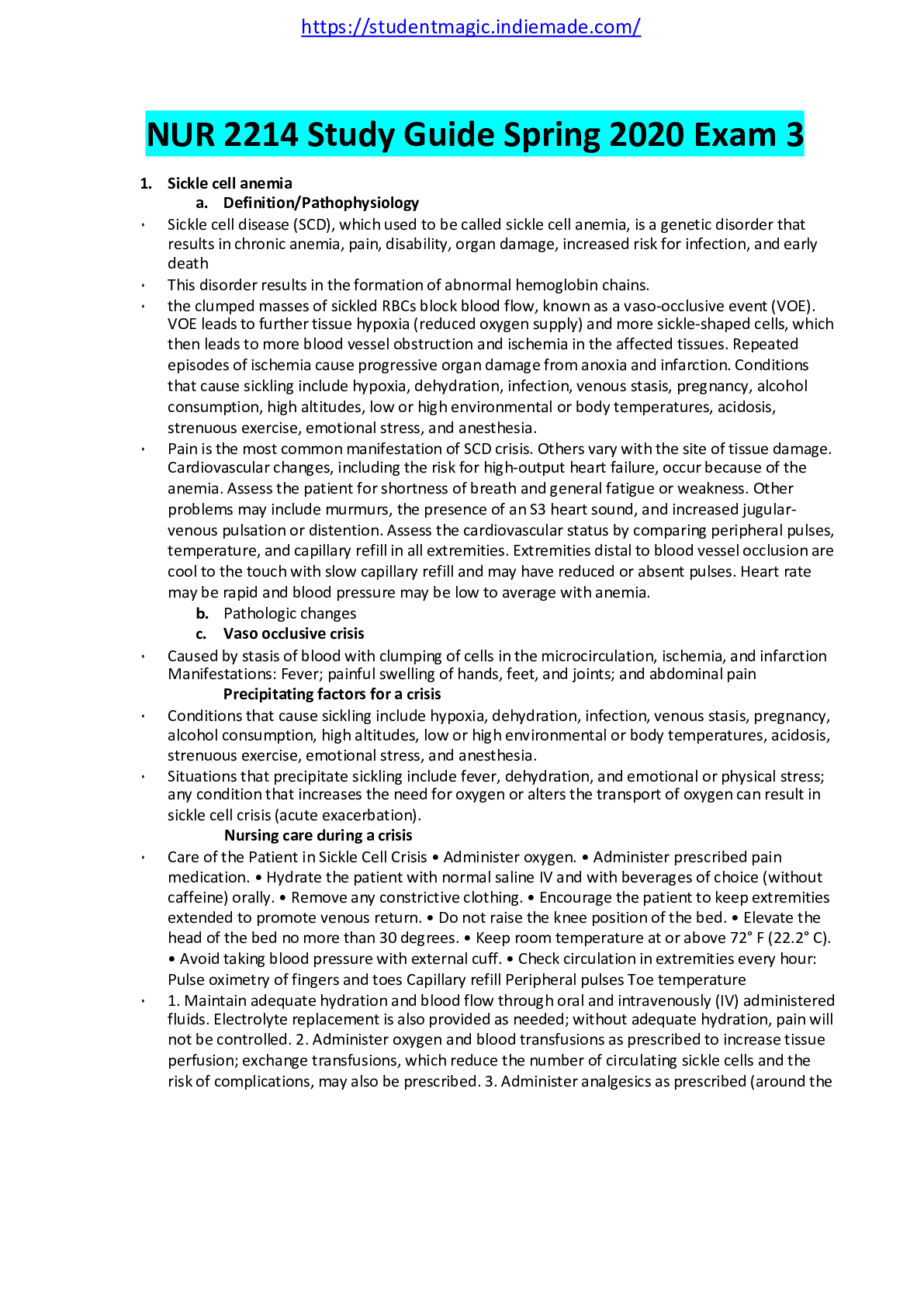*NURSING > STUDY GUIDE > ATI COMPREHENSIVE PREDICTOR EXAM- LATEST STUDY GUIDE (All)
ATI COMPREHENSIVE PREDICTOR EXAM- LATEST STUDY GUIDE
Document Content and Description Below
ATI COMPREHENSIVE PREDICTOR EXAM STUDY GUIDE- UPDATED 2021 1. A nurse is caring for a client who has bipolar disorder and is experiencing acute mania. The nurse obtained a verbal prescription for res... traints. Which of the following should the actions the nurse take? A. Request a renewal of the prescription every 8 hr. B. Check the client’s peripheral pulse rate every 30 min C. Obtain a prescription for restraint within 4 hr. D. Document the client’s condition every 15 minutes 2. A nursing planning care for a school-age child who is 4 hr postoperative following perforated appendicitis. Which of the following actions should the nurse include in the plan of care? a. Offer small amounts of clear liquids 6 hr following surgery (assess for gag reflex first) b. Give cromolyn nebulizer solution every 6 hr (for asthma) c. Apply a warm compress to the operative site every 4 hr d. Administer analgesics on a scheduled basis for the first 24 hr 3. A nurse is receiving change-of-shift report for a group of clients. Which of the following clients should the nurse plan to assess first? a. A client who has sinus arrhythmia and is receiving cardiac monitoring b. A client who has diabetes mellitus and a hemoglobin A1C of 6.8% c. A client who has epidural analgesia and weakness in the lower extremities d. A client who has a hip fracture and a new onset of tachypnea 4. A nurse is preparing to apply a transdermal nicotine patch for a client. Which of the following actions should the nurse tak e? a. Shave hairy areas of skin prior to application (apply to hairless, clean & dry areas to promote absorption; avoid oily or broken skin) b. Wear gloves to apply the patch to the client’s skin c. Apply the patch within 1 hr of removing it from the protective pouch (apply immediately) d. Remove the previous patch and place it in a tissue (fold patch in half with sticky sides pressed together) 5. A nurse has just received change-of-shift report for four clients. Which of the following clients should the nurse assess first? a. A client who was just given a glass of orange juice for a low blood glucose level b. A client who is schedule for a procedure in 1 hr (can wait) c. A client who has 100 mL fluid remaining in his IV bag (can wait) d. A client who received a pain medication 30 min ago for postoperative pain 6. A nurse is caring for a client who is receiving intermittent enteral tube feedings. Which of the following places the client at risk for aspiration? a. A history of gastroesophageal reflux disease b. Receiving a high osmolarity formula c. Sitting in a high-Fowler’s position during the feeding d. A residual of 65 mL 1hr postprandial 7. A nurse is reviewing the laboratory results for a client who has Cushing’s disease. The nurse should expect the client to have an increase in which of the following laboratory values? a. Serum glucose level- increased b. Serum calcium level-decreased c. Lymphocyte count- decreased immune system. d. Serum potassium level- decreased . 8. A nurse is caring for a client who has severe preeclampsia and is receiving magnesium sulfate intravenously. The nurse discontinues the magnesium sulfate after the client displaces toxicity. Which of the following actions should the nurse take? a. Position the client supine b. Prepare an IV bolus of dextrose 5% in water c. Administer methylergonovine IM d. Administer calcium gluconate IV Calcium gluconate is given for magnesium sulfate toxicity. Always have an injectable form of calcium gluconate available when administering magnesium sulfate by IV. 9. A charge nurse is teaching new staff members about factors that increase a client’s risk to become violent. Which of the following risk factors should the nurse include as the best predictor of future violence? a. Experiencing delusions b. Male gender c. Previous violent behavior d. A history of being in prison Risk factors also include: past history of aggression, poor impulse control, and violence. Comorbidity that leads to acts of violence (psychotic delusions, command hallucinations, violent angry reactions with cognitive disorders). Individual Assessment for Violence 10. A nurse is preparing to perform a sterile dressing change. Which of the following actions should the nurse take when setting up the sterile field? a. Place the cap from the solution sterile side up on clean surface b. Open the outermost flap of the sterile kit toward the body→ flap AWAY from the body's first c. Place the sterile dressing within 1.25 cm (0.5in) of the edge of the sterile field → 2.5 cm (1-inch) border around any sterile drape or wrap that is considered contaminated. d. Set up the sterile field 5 cm (2 in) below waist level→ it says BELOW waist level; should be ABOVE waist level 11. A nurse is providing teaching to an older adult client about methods to promote nighttime sleep. Which of the following instructions should the nurse include? a. Eat a light snack before bedtime b. Stay in bed at least 1 hr if unable to fall asleep c. Take a 1 hr nap during the day d. Perform exercises prior to bedtime 12. A home health nurse is preparing for an initial visit with an older adult client who lives alone. Which of the following actions should the nurse take first? a. Educate the client about current medical diagnosis b. Refer the client to a meal delivery program c. Identify environmental hazards in the home d. Arrange for client transportation to follow-up appointments Rationale Priority: Assess first. 13. A nurse is assessing the remote memory of an older adult client who has mild dementia. Which of the following questions should the nurse ask the client? a. “Can you tell me who visited you today?” b. “What high school did you graduate from c. “Can you list your current medications?” d. “What did you have for breakfast yesterday?” 14. A nurse is providing teaching to an adolescent who has type 1 diabetes mellitus. Which of the following goals should the nurse include in the teaching a. HbA1c level greater than 8%- 6.5 - 8 is the target reference. > b. Blood glucose level greater than 200 mg/dL at bedtime c. Blood glucose level less than 60 mg/dL before breakfast- < 70 = HYPOGLYCEMIC d. HbA1c level less than 7% 15. A nurse is caring for a client who is receiving phenytoin for management of grand mal seizures and has a new prescription for isoniazid and rifampin. Which of the following should the nurse conclude if the client develops ataxia and incoordination? a. The client is experiencing an adverse reaction to rifampin b. The client’s seizure disorder is no longer under control c. The client is showing evidence of phenytoin toxicity d. The client is having adverse effects due to combination antimicrobial therapy 16. A nurse is caring for a client who is 1 hr postoperative following rhinoplasty. Which of the following manifestations requires immediate action by the nurse? a. Increase in frequency of swallowing→ may indicate bleeding b. Moderate sanguineous drainage on the drip pad c. Bruising to the face→ side effect d. Absent gag reflex→ possibly due to anesthesia given. (1 hour postoperative) Rationale “Requires immediate action” choose the worst possibility that could lead to. ABC 17. A nurse is planning care for a preschool-age child who is in the acute phase Kawasaki disease. Which of the following interventions should the nurse include in the plan of care? a. Give scheduled doses of acetaminophen every 6 hr b. Monitor the child’s cardiac status c. Administer antibiotics via intermittent IV bolus for 24 hr d. Provide stimulation with children of the same age in the playroom 18. A nurse is planning an educational program for high school students about cigarette smoking. Which of the following potential consequences of smoking is most likely to discourage adolescents from using tobacco? a. Use of tobacco might lead to alcohol and drug abuse b. Smoking in adolescence increases the risk of developing lung cancer later in life c. Use of tobacco decreases the level of athletic ability d. Smoking in adolescence increases the risk of lifelong addiction 19. A nurse is assessing a client who is prescribed spironolactone. Which of the following laboratory values should the nurse monitor for this client? a. Total bilirubin b. Urine ketones c. Serum potassium- diuretic that retains potassium= hyperkalemic risk d. Platelet count Rationale ATI PDF p: 146 Pharm Complications: hyperkalemia 20. A nurse has agreed to serve as an interpreter for an older adult client who is assigned to another nurse. Which of the following statements by the nurse indicates an understanding of this role? a. “I will let the client know that I am available as the interpreter.” b. “I will receive a small fee for interpreting for this client.” c. “I am glad I’m available today, but when I’m not, you can use a family member.” d. “I will let the client know that an interpreter is unavailable during the night shift.” 21. A nurse is performing assessments on newborns in the nursery. Which of the following findings should the nurse report to the provider? a. A two day old newborn who has a respiratory rate of 70 --> 30 - 60 is normal b. A 16 hour old new newborn who has yet to pass meconium- you got 24 hours to pass stool c, A 2 day old newborn who has a small amount of blood tinged vaginal discharge d. A 16 hr old newborn whose blood glucose is 45 mg/dl- 40 - 60 is normal 22. A nurse on an acute unit has received change of shift report for 4 clients which of the following clients should the nurse assess first? Pain pallor pulselessness paresthesia a. A client who is 1 hr postoperative and has hypoactive bowel sounds b. A client who has fractured left tibia and pallor in the affected extremity c. A client who had a cardiac catheterization 3 hr ago and has 3+ pedal pulses d. A client who has a elevated AST level following administration of azithromycin 23. A nurse is providing discharge instructions to a client who has a new prescription for haloperidol which of the following adverse effects should the nurse instruct the client to report to the provider? a. Weight gain b. Dry mouth→ anticholinergic effects c. Sedation → s/s neuroleptic malignant syndrome??>> life threatening d. Shuffling gait →A/E EPS: is an indication of parkinsonism and should be reported to t 24. A nurse is planning discharge teaching about cord care for the parents of a newborn which of the following instructions should the nurse plan to include in the teaching? P . 177 ch 26 a. Clean the base of the cord with hydrogen peroxide daily- only with tub and sponge baths b. The cord stump will fall off in 5 days- about 10 - 14 days c. Contact the provider if the cord stump turns black d. Keep the cord stump dry until it falls off Rationale: cord usually falls out within 7 to 10 days. Clean with soap and water. Cord is expected to turn black and dry. 25. A nurse is teaching dietary guidelines to a client who has celiac disease which of the following food choices is appropriate for the client? a. White flour tortillas c. Wheat crackers d. Canned barley soup 26. A nurse is working in acute care mental health facility is assessing a client who has schizophrenia. Which of the following findings should the nurse expect? a. All or nothing thinking b. Euphoric mood d. Hypochondriasis ( anxiety disorder) 27. A nurse is caring for a client who is immobile which of the following interventions is appropriate to prevent contracture? a. Align a trochanter wedge between the clients legs b. Place a towel roll under the clients neck d. Position a pillow under the client's knees 28. A public health nurse working in a rural area is developing a program to improve health for the local population. Which of the following actions should the nurse plan to take? a. Provide anticipatory guidance classes to parents through public schools b. Have a nurse from the outside the community provide health lectures at the county hospital c. Encourage rural residents to focus health spending on tertiary health interventions d. Launch a media campaign to increase awareness about industrial pollution 29. A nurse in the emergency department is performing triage for multiple clients following a disaster in the community. To which of the following types of injuries should the nurse assign the highest priority? a. Below the knee amputation → ESI Level 1 b. 10cm (4 in) laceration → ESI Level 4 c. Fractured tibia → ESI Level 2; if pelvis, femur, or hip and other extremity dislocation then level 1. d. 95% full thickness body burn → 30. A nurse is preparing a change of shift report for an adult female client who is postoperative. Which of the following client information should the nurse include in the report? CONFIRMED a. Hgb 12.8 g/dl - 12- 16 b. Potassium 4.2 meq/l 3.5 - 5.0 meq c. RBC 4.4 million/mm3 d. Platelets 100,000/mm3 - 150,000 - 300,000 risk for bleeding 31. A nurse is admitting a client who has anorexia nervosa. Which of the following is an expected finding? a. Iron 90 mcg/dl b. Prealbumin 10 mcg/dl (normal: 16-40) c. Serum creatinine 0.8 mg/dl d. Calcium 9.5 mg/dl 32. A charge nurse on a medical-surgical unit is planning assignments for a licensed practical nurse (LPN) who has been sent from the postpartum unit due to a staffing shortage for the shift. Which of the following client assignments should the nurse delegate to the LPN? b. A client who has fractured a femur yesterday and is expecting SOB c. A client who sustained a concussion and has unequal pupils d. A client who has an Hgb of 6.3 g/dl and a prescription for packed RBCs 33. A nurse is caring for a client who is at 41 week of gestation and is receiving oxytocin for labor induction. The nurse notes early deceleration on the fetal heart rate monitor . Which of the following nursing actions should the nurse take ? p . 88 ch 13 maternity b. Stop the oxytocin infusion c. Perform a vaginal examination d. Initiate an amnioinfusion 34. A nurse is conducting an initial assessment of a client and noticed a discrepancy between the clients current IV infusion and the information received during the shift report. Which of the following actions should the nurse take? a. Complete an incident report and place it in the client's medical record. c. Contact the charge nurse to see if the prescription was changed. d. Submit a written warning for the nurse involved in the incident. 35. A nurse is reviewing the medical record of a client who has schizophrenia and is taking clozapine. Which of the following findings should the nurse identify as a contraindication to the administration of clozapine ? b. FAsting blood glucose 100 mg/dl c. Hgb 14 g/Dl d. Heart rate 58/min ATI PHARM 116 Complications 36. A nurse is caring for a client who is at 38 weeks of gestation and has a history of hepatitis C. The client asks the nurse if she will be able to breastfeed. Which of the following responses by the nurse is appropriate? b. You must use a breast pump to provide breast milk. c. You must use nipple shield when breastfeeding. d. You may breastfeed after your baby develops his antibiotics. 37. A nurse is caring for a client who has returned to the medical-surgical unit following a transurethral resection of the prostate. Which of the following should the nurse identify as priority nursing assessment after reviewing the clients information? Exhibit. b. Skin turgor d. Bowel sounds 38. A nurse is caring for a client who has hyperthermia .Which of the following actions for the nurse to take ? a. Submerge the adolescent feet in ice water b. Cover the adolescent with a thermal blanket → if hypothermia. c. Administer oral acetaminophen 39. A nurse manager is updating protocols for belt restraints. Which of the following guidelines should the nurse include. b. Attach the restraints to the beds side rails c. Request a PRN restraints prescription for clients who are aggressive d. Remove the client restraints every 4 hours 40. A nurse in emergency department is caring for a client who has full thickness burn of the thorax and upper torso. After securing the client's airway, which of the following is the nurse's priority intervention? P. 482 ch 75 CONFIRMED a. Providing pain management b. Offering emotional support c. Preventing infection 41. A nurse is caring for a client who has cancer and is being transferred to hospice care. The client’s daughter tells the nurse, “I’m not sure what to say to my mom if she asks me about dying.” which of the following responses by the nurse is appropriate? (SATA) A. Hospice will take good care of your mom, so I wouldn’t worry about that. D. Tell her not to worry. She still has plenty of time left. Rationale: Therapeutic communication 42. A nurse is reviewing the medical records of four clients. The nurse should identify that which of the following client findings follow up care? a. A client who is taking bumetanide and has potassium level of 3.6 mEq/L (normal) b. A client who is scheduled for colonoscopy and taking sodium phosphate d. A client who is taking warfarin and has INR of 1.8 (normal if taking warfarin) 43. A community health nurse receives a referral for a family home visit. Which of the following tasks should the nurse perform first? b. Implement the nursing process c. Schedule a time for the home visit d. Contact the family by phone ! 44. A nurse is caring for a client who will undergo a procedure. The client states he does not want the provider to discuss the results with his partner. Which of the following is an appropriate response for the nurse to make? b. Your partner can be a great source of support for you at this time c. Is there a reason you don’t want your partner to know about your procedure? d. The provider will be tactful when talking to your partner 45. A nurse is discussing a weight loss with a client who is concerned about losing 6.8 kg (15lb) from an original weight of 9o.7 (200 lb). The nurse should identify the weight of the following total percentage? b. 15% c. 8.1% d. 13.3% 46. A nurse is caring for a client who is 4 hr postpartum and reports that she cannot urinate. Which of the following interventions should the nurse implement? a. Perform fundal massage ( massage if fundus is boggy) c. Insert an indwelling urinary catheter. d. Apply cold therapy to the client’s perineal area.( warm) 47. A nurse is providing discharge teaching to a client who has cancer and a prescription for a fentanyl 25 mcg /hr transdermal patch. Which of the following instructions should the nurse include in the teaching? b. Apply patch to your forearm c. Avoid high-fiber foods while taking this medication d. Remove the patch for 8 hours every day to reduce the risk for tolerance. 48. A nurse working on a surgical unit is developing a care plan for a client who has paraplegia. The client has an area of non-blanchable erythema over his ischium. Which of the following interventions should the nurse include in the care plan? b. Place the client upright on a donut-shaped cushion c. Assess pressure points every 24 hr.- must assess d. Turn and reposition the client every 3 hrs. while in bed. - must be q 2 hours in bed, 1 hour in chair. 49. A nurse is working with a client who has an anxiety disorder and is in the orientation phase of the therapeutic relationship. Which of the following statements should the nurse make during this phase? a. We should discuss resources to implement in your daily life b. Let me show you simple relaxation exercises to manage stress. c. Let’s talk about how you can change your response to stress 50. A nurse is providing discharge teaching to a client who has a new prescription for phenelzine. The nurse should instruct the client that it is safe to eat which of the following foods while taking this medication? a. Avocados c. Pepperoni pizza d. Smoked salmon ????? 51. A nurse enters a client’s room and sees a small fire in the client’s bathroom. Identify the sequence of steps the nurse should take. (Move the steps into the box on the right, placing them in the selected order of performance. Use all steps) a. Transport the client to another area of the nursing unit (1) b. Activate the facility’s fire alarm system (2) c. Close all nearby windows and doors (3) d. Use the unit’s fire extinguisher to attempt to put out the fire (4) 52. A nurse is caring for a client who is experiencing mild anxiety. Which of the following findings should the nurse expect? b. Rapid speech -severe c. Feelings of dread d. Purposeless activity 53. A nurse is caring for a client who has type 1 diabetes mellitus. The client reports that she is not feeling well. Which of the following findings should indicate to the nurse that the client is hypoglycemic? (Select all that apply.) b. Polydipsia = hyperglycemia c. Acetone Breath odor = DKA 54. A nurse is caring for an infant who has coarctation of the aorta. Which of the following should the nurse identify as an expected finding? a. Upper extremity hypotension b. Increased intracranial pressure c. Frequent nosebleeds 55. A community health nurse is planning primary prevention activities to reduce the occurrence of abuse. Which of the following strategies should the nurse include in the plan? a. Instruct healthcare professionals to identify abusive situations (screening=secondary prevention) b. Locate financial support to open a shelter for abuse survivors (3rd) d. Connect abuse survivors with legal counsel (3rd) 56. A nurse and an assistive personnel (AP) are caring for a group of clients. Which of the following tasks is appropriate for the nurse to delegate to the AP? a. Documenting the report of pain for a client who is postoperative b. Administering oral fluids to a client who has dysphagia- d. Reviewing active range-of-motion exercise with a client who had a stroke 57. A nurse is providing teaching to an adolescent who has peptic ulcer disease. Which of the following statements by the client indicates an understanding of the teaching? a. “I will take sucralfate with meals three times per day” c. “I will decrease my daily protein intake to 15 grams per day” d. “I will use ibuprofen as needed to control abdominal pain” 58. A nurse is caring for a client who reports xerostomia following radiation therapy to the mandible. Which of the following is an appropriate action by the nurse? a. Offer the client saltine crackers between meals b. Suggest rinsing his mouth with an alcohol-based mouthwash c. Provide humidification of the room air d. Instruct the client on the use of esophageal speech 59. A nurse is caring for four clients. Which of the following tasks can the nurse delegate to an assistive personnel? a. Assess effectiveness of antiemetic medication- b. Perform chest compressions during cardiac resuscitation- c. Perform a dressing change for a new amputee- d. Apply a transdermal nicotine patch- *60. A nurse is caring for a client who states he recently purchased lavender oil to use when he gets the flu. The nurse should recognize which of the following findings as a potential contraindication for using lavender? a. The client takes vitamin C daily b. The client has a history of alcohol use disorder c. The client has a history of asthma d. The client takes furosemide twice daily 61. A nurse is caring for a client who has major depressive disorder and a new prescription for amitriptyline. The nurse should monitor for which of the following adverse effects? a. Increased salivation- dry it will cause - anticholinergic effects b. Weight loss d. Hypertension- orthostatic hypotension it will cause instead 62. A nurse is conducting a health promotion class about the use of oral contraceptives. Which of the following disorders is a contraindication for oral contraceptive use? a. Asthma c. Fibromyalgia d. Fibrocystic breast condition 63. A nurse is preparing to witness a client’s signature on a consent form for a colon resection. The nurse should recognize that which of the following information should be provided to the client by the provider before signing the form? (SATA) e. Cost of the procedure 64. A nurse is providing teaching to a client who will undergo a magnetic resonance imaging (MRI) scan. Which of the following statements is appropriate to include in the teaching? b. “You should not have this procedure if you have a tattoo.” c. “The nurse will ask you to wear protective eyewear during this procedure.” d. “The nurse will ask you to remove any transdermal patches prior to the procedure.” 65. A nurse in a provider’s office is reviewing a female client’s medical record during a routine visit. The nurse should recommend increasing dietary intake of which of the following vitamins? (Exhibit) --only tab shown is Tab 3: H&P: postmenopausal, hx DVT and iron deficiency anemia, works indoors, consumes 1-2 alcoholic beverages per week a. Vitamin D b. Vitamin K c. Vitamin A d. Vitamin B12 66. A nurse is caring for a child who has sickle cell anemia and experiencing vaso-constrictive crisis. Which of the following actions should the nurse include in the plan of care? a. Initiate IV fluid replacement- b. Start a 24-hr urine collection- not the priority c. Give aspirin to reduce pain- acetaminophen or ibuprofen. Asa might lead to reye's disease d. Encourage ambulation- we want to promote rest to decrease 02 consumption 67. A nurse is teaching a parent about safety securing her 3-month-old infant in a car seat. Which of the following images indicates that the parent understands the teaching? B a. . C and D not shown 68. A nurse is caring for an adult client who has chronic anemia and is scheduled to receive a transfusion of 1 unit of packed RBCs. Which of the following actions should the nurse take? P. 249 med surg pdf a. Check the client’s vital signs from the previous shift prior to the initiation of the transfusion- assess prior to infusion then be with them for first 15 - 30 minutes. b. Set the IV infusion pump to administer the blood over 6 hr d. Administer the blood via a 21-gauge IV needle 69. A nurse is caring for a client who is dissatisfied with the care from the provider and decides to leave the facility against medical advice. After notifying the provider, which of the following actions is appropriate for the nurse to take? a. Summon a security guard b. Explain the risks of leaving c. Complete an incident report d. Notify a social worker Rationale: 70. A nurse is making an initial postpartum home visit. Which of the following client statements should the nurse identify as a manifestation of increased risk for child abuse? a. “I try to respond to the baby quickly .” b. “I think the baby should be sleeping through the night by now. c. “I have several friends who come by to help out with the baby.” d. “I want to meet other parents to see if they are going through the same thing.” 71. A nurse is caring for an infant who has gastroenteritis. Which of the following assessments should the nurse report to the provider? a. Temperature 38 C(100.4 F) and pulse rate 124/min p b. Decreased appetite and irritability c. Pale and 24-hour fluid deficit of 30 mL d. Sunken fontanels and dry mucous membranes 72. A nurse is admitting a client who is 1 week postpartum and reports excessive vaginal bleeding, The nurse does not speak the same language as the client . The client partner and a 10 year old child are accompanying her. Which of the following actions should the nurse take to gather the clients information? Request a female translator interpreter through the facility a. Ask a student nurse who speaks the same language to translate b. Have the child translate c. Allow the clients partner to translate 73. A nurse is caring for a client who has pernicious anemia, Which of the following laboratory values should the nurse evaluate effectiveness of the treatment ? A. Folate level B. INR level C. Vitamin b12 level D. Creatinine level 74. A nurse is assigning tasks to assistive personnel(AP). Which of the following tasks should the nurse assign to the AP? a. Suction a new tracheostomy b. Remove an NG tube c. Perform post mortem care d. Change the dressing on an implanted central venous access device 75. A nurse is caring for a client who is postpartum and reports difficulty voiding. Which of the following findings should indicate to the nurse that the client’s ability to eliminate urine from the bladder is restored? a. Two voids of 150 mL each over the past 2 hours= 2 x 30 = 60 mls b. Fundus 2 fingerbreadths above the umbilicus( needs to be below or at the umbilicus) c. Uterine atony( fundus not firm which means possible hemorrhage) d. Fundus firm and to the right of the abdominal midline( fundus not midline, bladder may cause shifting if patient not voiding properly) 76. A nurse is caring for a client who has acute glomerulonephritis .Which of the following should the nurse expect ? a. Polyuria- oliguria b. Hypotension- hypertension d. Weight loss - weight gain 77. A nurse is providing teaching to a client about the adverse effects of sertraline. Which of the following effects should the nurse include ? p. 50 ch 7 pharm pdf SSRI for social anxiety , PTSD, B. Increased urinary frequency C. Dry cough D. Metallic taste in mouth 78. A nurse is providing teaching to the parents of a newborn about genetic screening. Which of the following statements should the nurse include in the teaching? a. your baby will be given 2 ounces of water to drink prior to the test b. this test will be repeated when your baby is 2 months old c. a nurse will draw blood from your baby’s inner elbow d. this test should be performed after you baby is 24 hours old 79. a nurse is caring for a child who has cystic fibrosis and requires postural drainage. Which of the following actions should the nurse take? a. perform the procedure prior to meals : AVOID Before or AFTER meals b. perform the procedure twice a day c. administer a bronchodilator after the procedure- d. hold hand flat to perform percussions on the child- 80. a nurse is preparing an inservice for a group of nurses about malpractice issues in nursing. Which of the following examples should the nurse include in the teaching? a. placing a yellow bracelet on a client who is at risk for falls→ correct approach; yellow bracelet indicates fall risk b. administering potassium via IV bolus c. documenting communication with a provider in the progress notes of the client’s medical record d. leaving a nasogastric tube clamped after administering oral medication → 81. A nurse in a clinic is assessing a client who reports frequent headaches. Identify the area the nurse should palpate to check the client’s maxillary sinus for tenderness. R: p147 ati funds Palpate the maxillary sinuses by pressing upward at the skin crevices that run from the sides of the nose to the corner of the mouth. 82. A nurse is caring for an adolescent client who has cystic fibrosis. Which of the following actions should the nurse instruct the client to take prior to initiating postural drainage? a. Take pancrelipase b. Complete oral hygiene c. Eat a meal 83. A nurse is caring for a client following a cardiac catheterization through the left groin. Which of the following actions should the nurse take? P . 164 ch 27 medsurge b. Maintain strict bedrest for first 12 hr- only for prescribed time, older adults usally are up to 4 hours. c. Keep the client NPO for 24 hr- doesn’t say anything about restrictions AFTER the procedure , and npo b4 the procedure is uP to 8 hours. d. Place the client in Fowler’s position- supine they must be 84. A nurse is caring for a client who has depression and is experiencing loss of appetite. Which of the following actions should the nurse take? b. Recommend the family provide the client privacy during meals c. Weigh the client once each day d. Encourage the client to eat foods selected by the dietitian 85. A nurse is caring for a client who requests to ambulate in the hallway with his own clothing. The nurse is demonstrating which of the following ethical principles when respecting the client's decision to wear his own clothing ? a. Non maleficence b. Veracity d. Justice R: p47 ati leadership Autonomy: The ability of the client to make personal decisions, even when those decisions might not be in the client’s own best interest 86. A nurse in an emergency department is caring for a toddler who has burns following a house fire. Which of the following actions should the nurse take first ? B. Calculate the fluid replacement based on vital signs and urinary output C. Determine the location and depth of burns D. Administer antibiotics to prevent sepsis. 87. A nurse is assessing a client who had heart failure is taking furosemide. Which of the following findings should the nurse monitor ? b. Hyperkalemia- c. Hypercalcemia d. hypoglycemia 88. a nurse Is caring for a client who weighs 75 kg. the client has a prescription from a dietician to decrease calorie intake by 500 cal/day for 25 weeks produce a weight loss of 1 pound per week. What is the expected goal weight for the client in pounds at the end of the 25 weeks? (round the answer to the nearest whole number. Use leading zero if it applies. No trailing Zero) 140??(not sure) pounds 1 lb per week x 25 week= 25 lbs 75 x 2.2= 165 lbs 165 lbs-25 lbs=140 lbs or 63.6 kg (64 kg) 89. a nurse is providing discharge teaching about circumcision care to a parent of a newborn. Which of the following statements by the parent indicates an understanding of the teaching? a. I will change my baby’s diaper at least every 4 hours b. I will apply an ice pack to my baby’s penis twice daily to decrease swelling c. I will wash the penis with soap and warm water until the circumcision has healed d. I will apply topical lidocaine following each diaper change Teach the parents to keep the area clean. 90. a home health nurse is caring for an adult client who reports, “I keep coughing when I try to swallow my food, but not at other times.” Which of the following actions should the nurse take? a. encourage the client to increase fluid intake b. initiate a consultation with a speech→ language pathologist; swallow eval c. instruct the client that this is due to increased salivary flow that occurs with aging d. recommend an antitussive 30 minutes prior to each meal R: p56 AMS Refer to speech language therapist for dysarthria and dysphagia. 91. A nurse is caring for a client who is insulin dependent and is undergoing tests to determine if his blood glucose is being adequately controlled. The nurse should identify that which of the following laboratory values is the best indicator of adequate blood glucose control? A. Postprandial blood glucose 190 mg/dl B. Fasting blood glucose 60 mg/dl C. HbA1c 6.5% D. Hct 42% 92. A nurse is planning to administer Atenolol to a client. Which of the following should the nurse assess prior to administering the medication? A. BUN B. Blood pressure C. Respiratory rate D. aPTT 93. A nurse is orienting a newly licensed nurse while caring for clients who are in labor. Which of the following pain management strategies by the newly licensed nurse requires intervention? A. Encouraging the client to use jet therapy on her lower back for 1 hr B. Placing a transcutaneous electrical nerve stimulation (TENS) unit on a client’s abdomen C. Using effleurage on a client’s lower abdomen D. Instructing a client’s partner how to apply counterpressure to the client’s sacral spine for 30 min 94. A nurse has identified tasks to delegate to a group of assistive personnel (AP) after receiving change-of-shift report. Identify the sequence of steps the nurse should follow when delegating tasks to the APs. A. Review the skill level of and qualifications of each AP 1 B. Communicate appropriate tasks to the APs with specific expectations 2 C. Monitor progress of task completion with each AP 3 D. Evaluate the APs’ performance of each task 4 95. A nurse is teaching a prenatal class about infection prevention at a community center. Which of the following statements by a client indicates an understanding of the teaching? A. “I should take antibiotics when I have a virus.” B. “I should wash my hands for 10 seconds with hot water after working in the garden.” C. “I can clean my cat’s litter box during my pregnancy.” D. “I can visit my nephew who has chickenpox 5 days after the sores have crusted.” 96. A nurse I caring for a school-age child who is 2 hr postoperative following a cardiac catheterization. The nurse observes blood on the child’s dressing. Which of the following actions should the nurse take? A. Apply intermittent pressure 2.5 cm (1 in) below the percutaneous skin site. B. Apply continuous pressure 2.5 cm (1 in) below the percutaneous skin site. C. Apply continuous pressure 2.5 cm (1 in) above the percutaneous skin site. D. Apply intermittent pressure 2.5 cm (1 in) above the percutaneous skin site. 97. A nurse is reviewing the medical record of a client who has a prescription for intermittent heat therapy for a foot injury. Which if the following findings should the nurse identify as a contraindication for heat therapy? A. Phlebitis B. Abdominal aortic aneurysm C. Osteoarthritis D. Peripheral neuropathy CONTINUED..............DOWNLOAD FOR BEST SCORES [Show More]
Last updated: 1 year ago
Preview 1 out of 34 pages
Instant download

Instant download
Reviews( 0 )
Document information
Connected school, study & course
About the document
Uploaded On
Mar 08, 2022
Number of pages
34
Written in
Additional information
This document has been written for:
Uploaded
Mar 08, 2022
Downloads
0
Views
39

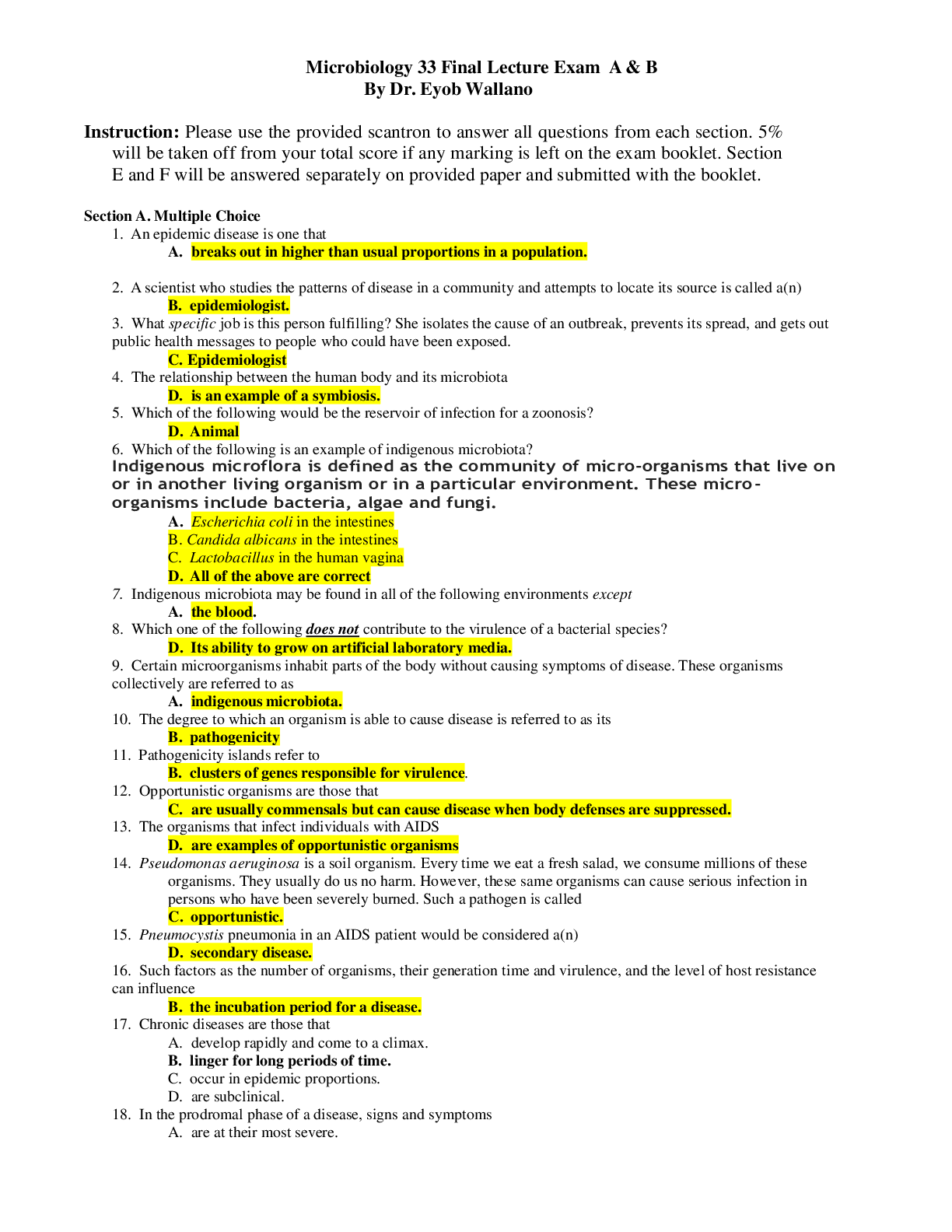
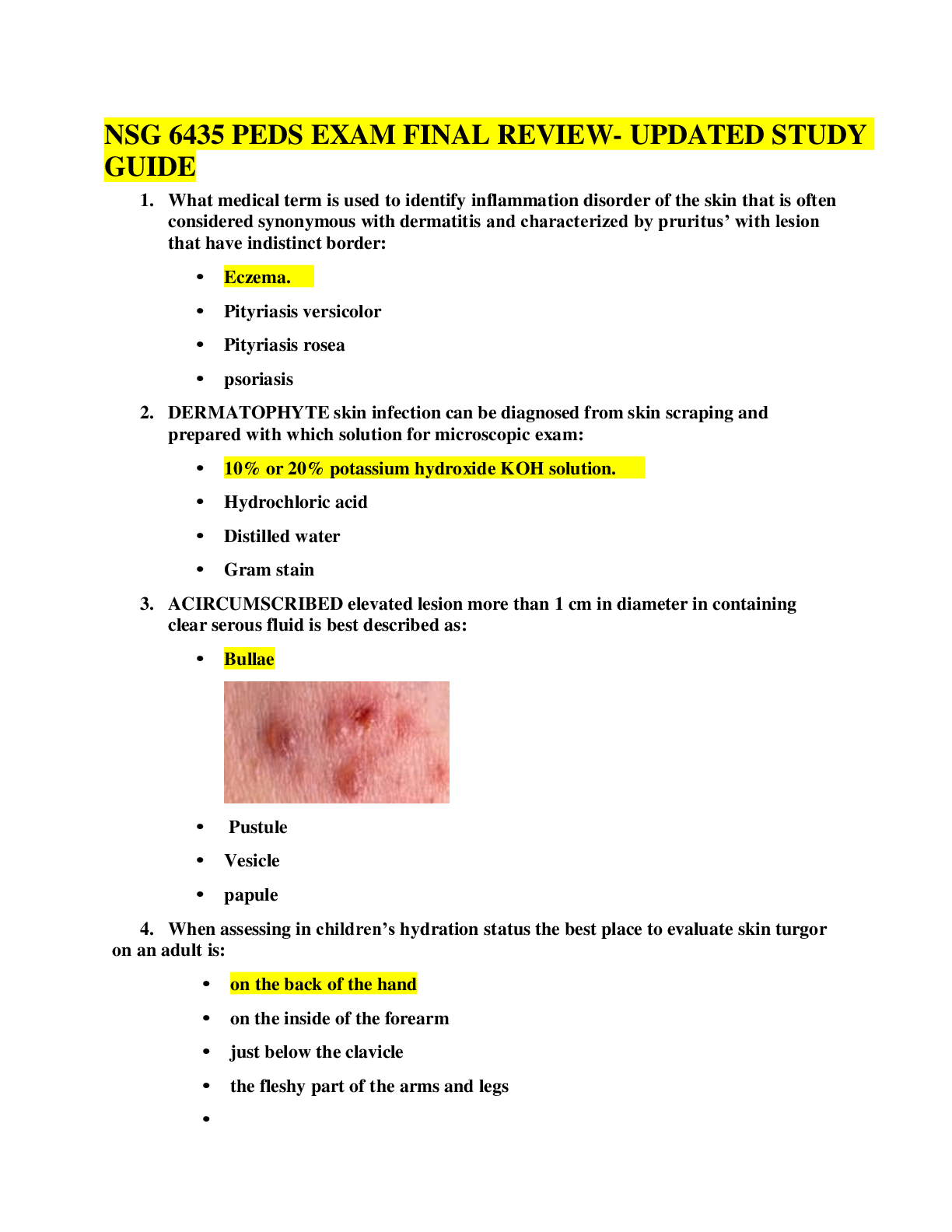




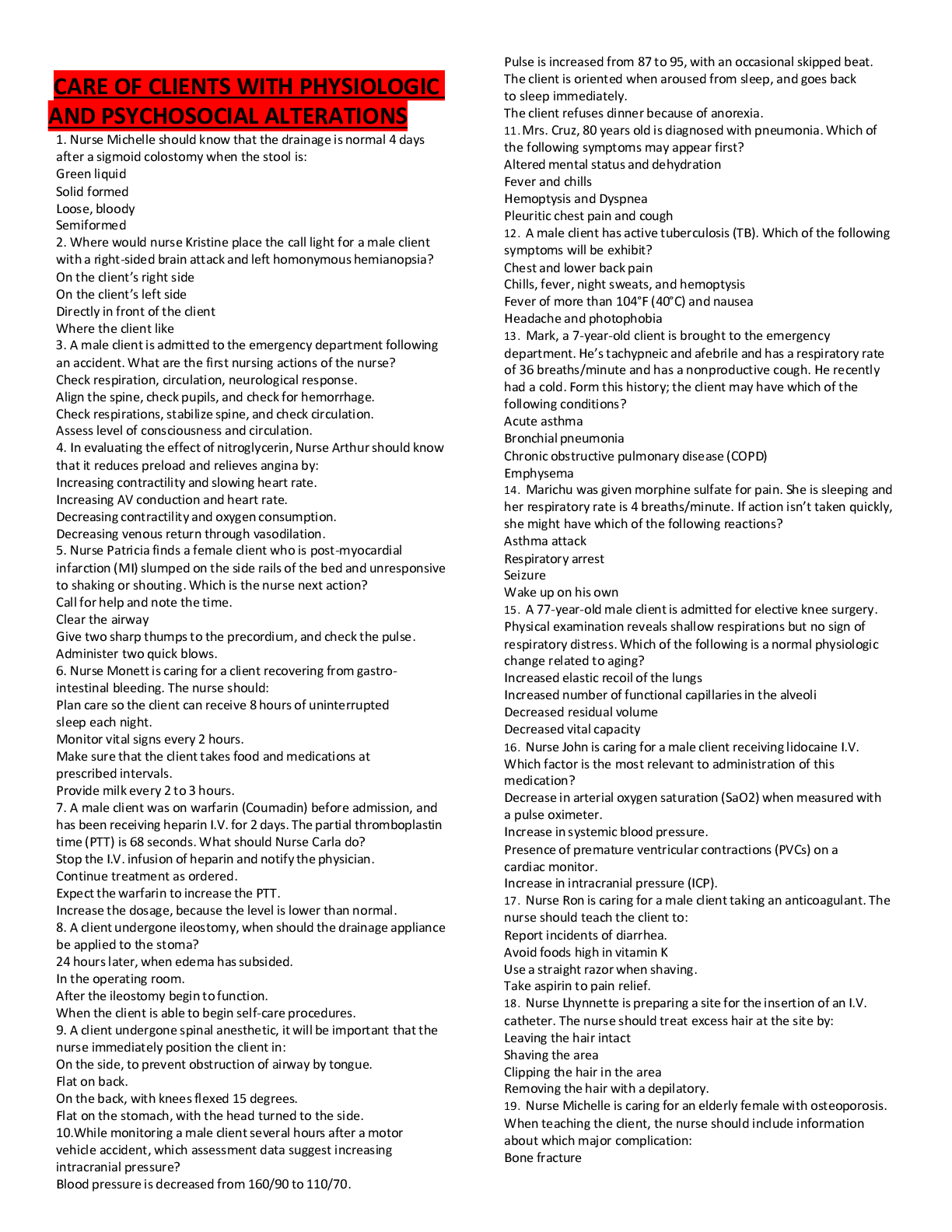



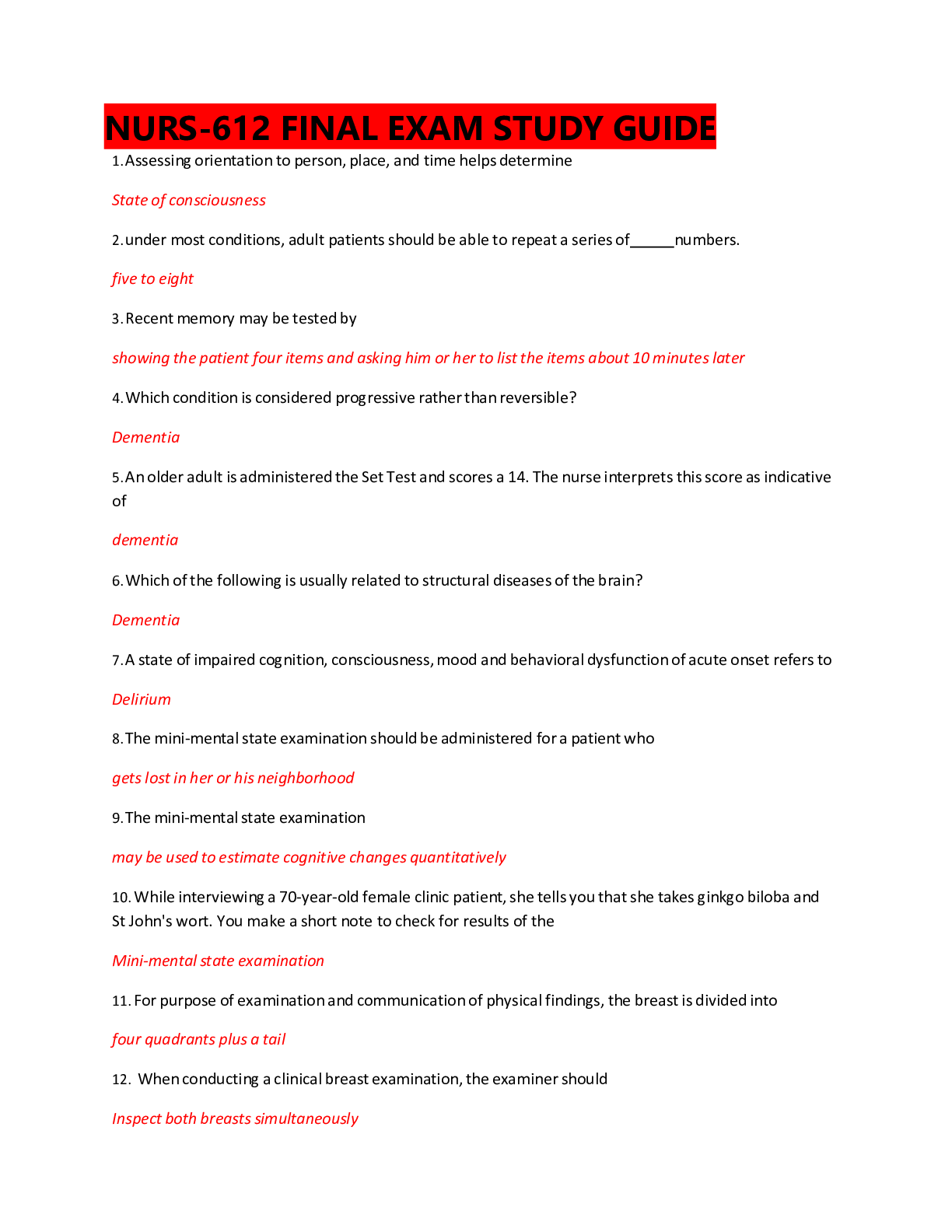
 BMAL 590- QUANTITATIVE RESEARCH TECHNIQUES AND STATISTICS TEST WITH SUMMARIZED STUDY GUIDE.png)
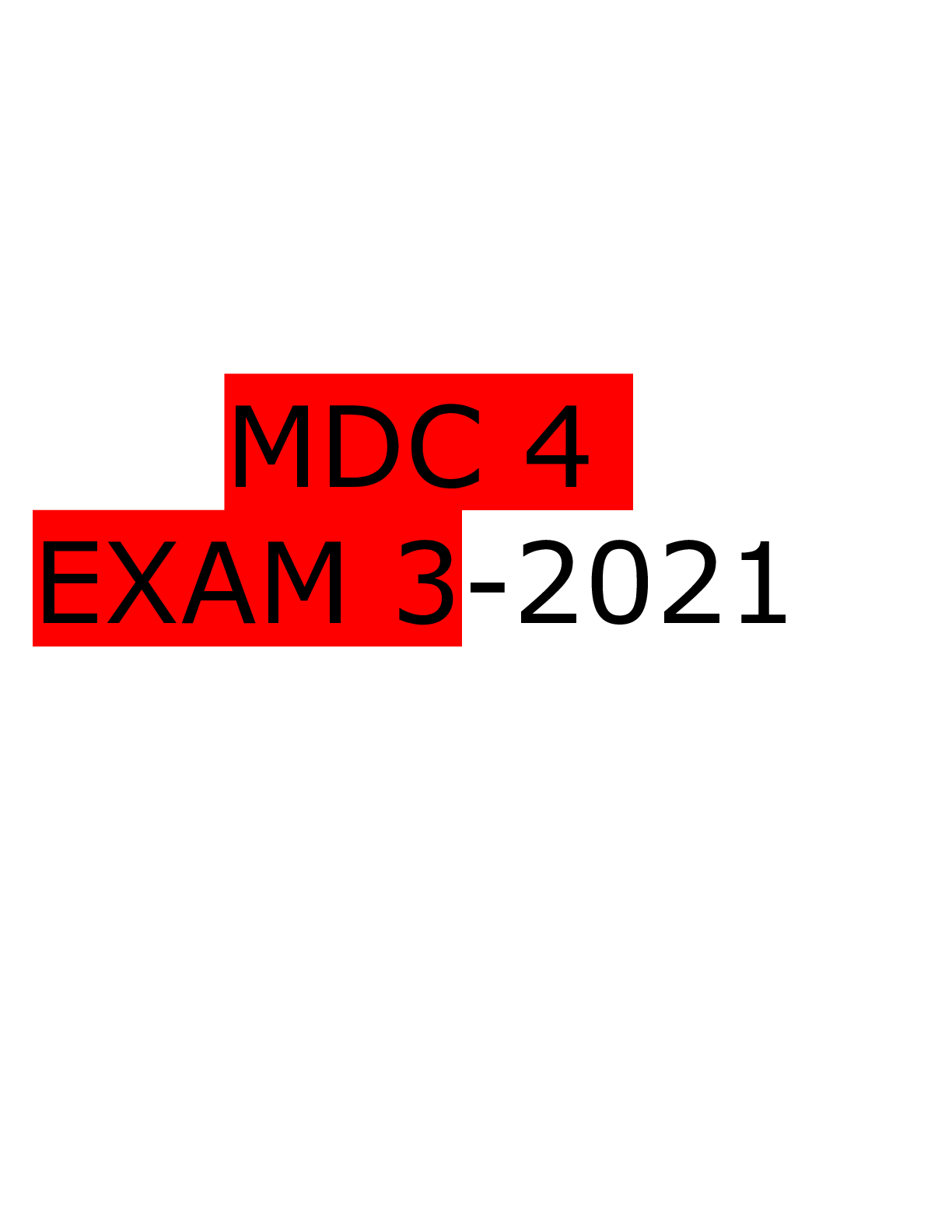
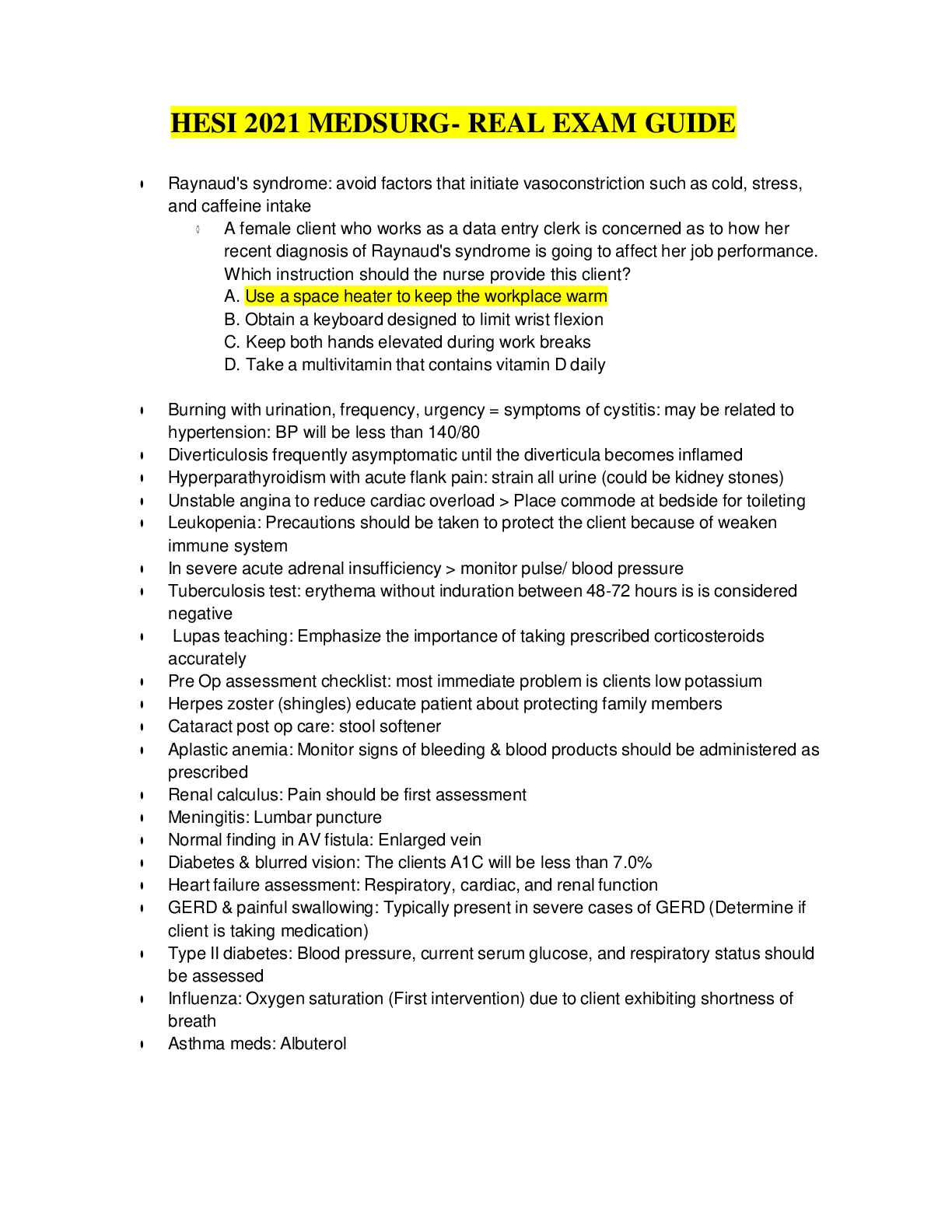


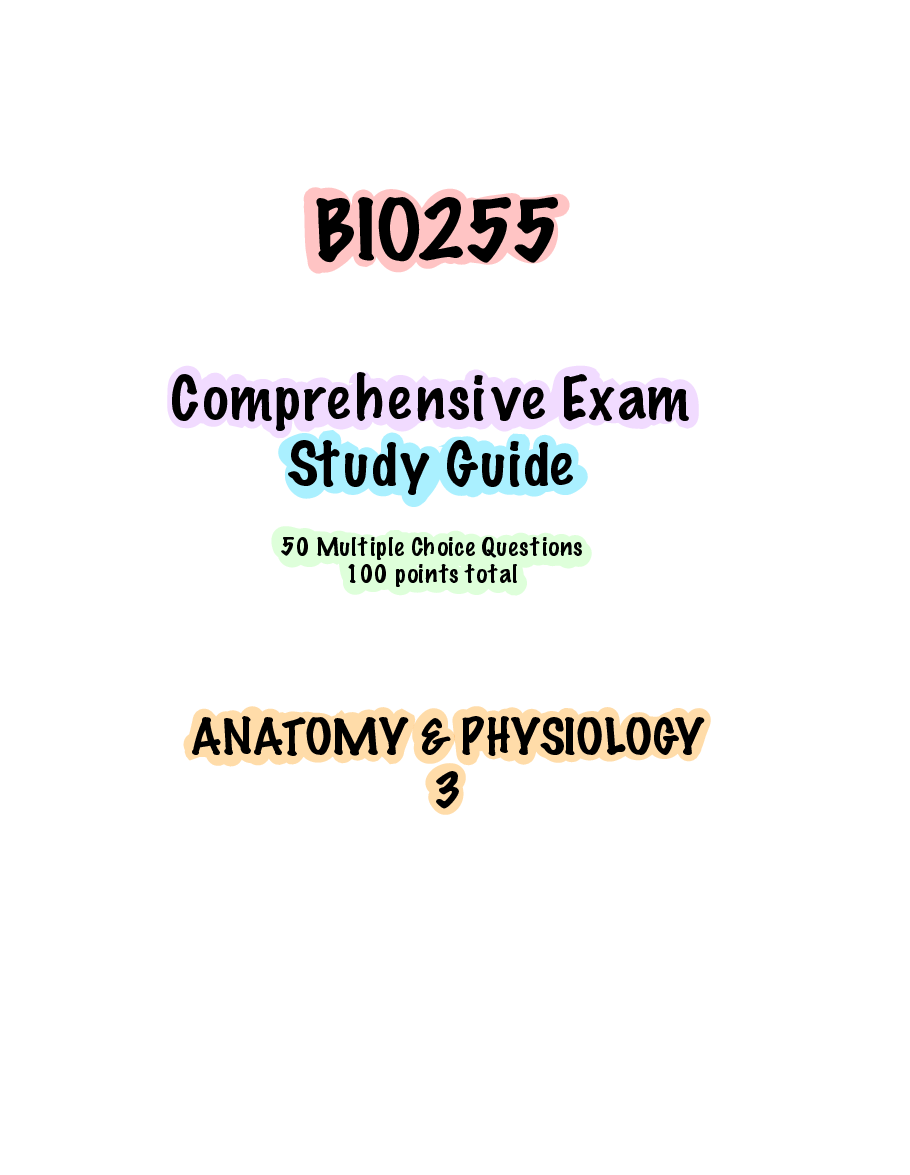

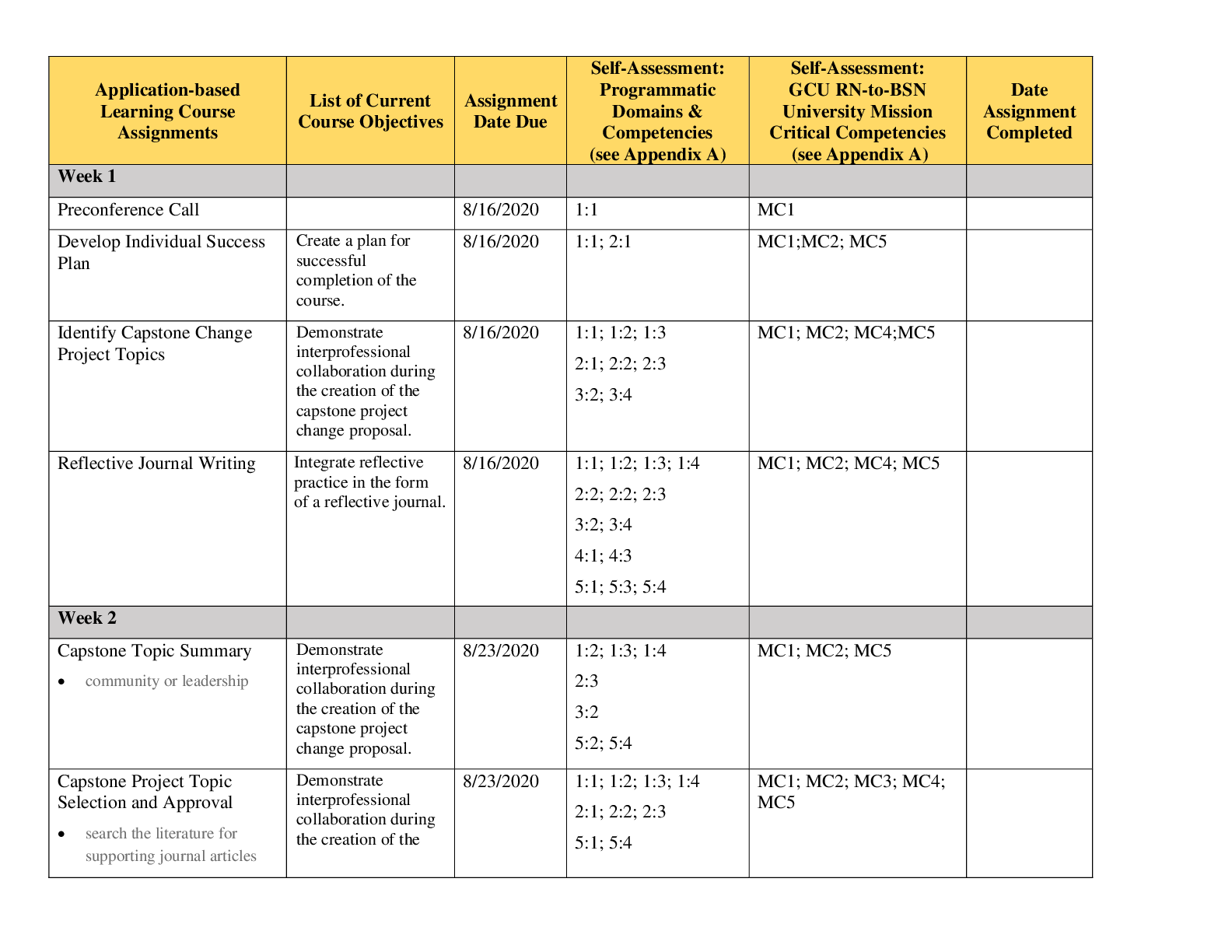






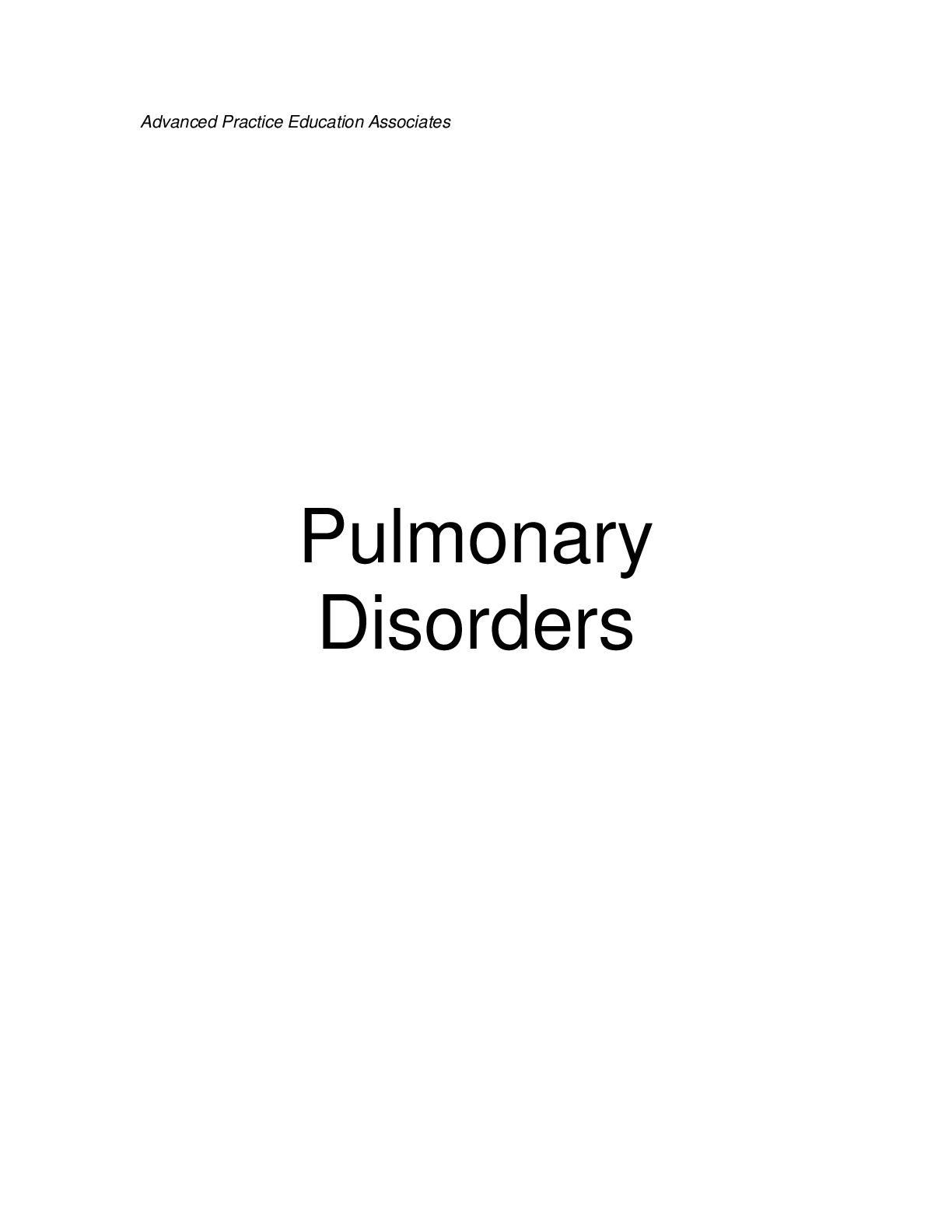
.png)





